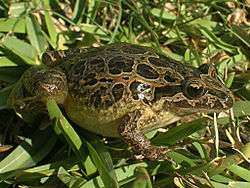Iberian painted frog
| Iberian painted frog | |
|---|---|
 | |
| Scientific classification | |
| Kingdom: | Animalia |
| Phylum: | Chordata |
| Class: | Amphibia |
| Order: | Anura |
| Family: | Alytidae |
| Genus: | Discoglossus |
| Species: | D. galganoi |
| Binomial name | |
| Discoglossus galganoi Capula, Nascetti, Lanza, Bullini & Crespo, 1985 | |
 | |
| Synonyms | |
|
Discoglossus hispanicus Lataste, 1879 | |
The Iberian painted frog (Discoglossus galganoi, in Spanish sapillo pintojo ibérico) is a species of frog in the family Alytidae (formerly Discoglossidae). It is found in Portugal and Spain, where its natural habitats are temperate forests, temperate shrubland, Mediterranean-type shrubby vegetation, rivers, intermittent rivers, swamps, freshwater marshes, intermittent freshwater marshes, sandy shores, arable land and grassland. It is threatened by habitat loss.
Description
This small frog has a broad head and stout body. It usually has longitudinal rows of warts on its back, but these are not present in all individuals. The pupil of the eye is said to resemble an "upside-down droplet". This frog comes in three different coloured forms; a plain shade of greyish-brown, a pattern of large dark spots with pale rims; and a dorsal and two lateral bright bands on a dark background.[2]
Distribution and habitat
The Iberian painted frog is endemic to Spain and Portugal. It occurs at altitudes of up to 1,940 metres (6,360 ft) and its typical habitats include open areas, rough grassland, thickets, woodland verges, swamps and gulleys, usually in or near water.[1]
Biology
The breeding period usually lasts from October to December. Females mate several times and can produce as many as 5,000 eggs in several clutches during the season. The eggs are laid in water either singly or in small groups, on the bottom or attached to plants. They hatch after two to six days according to the temperature. The tadpoles undergo metamorphosis after between twenty-two and sixty days of development and the juveniles are about one centimetre (0.4 in) long when they leave the water.[2]
Status
The Iberian painted frog is listed by the IUCN as being of "Least Concern". It is common over most of its range and the number of individuals may be declining slowly but the rate of loss is not sufficient to justify placing it in a more threatened category.[1]
References
- 1 2 3 Jaime Bosch; Pedro Beja; Miguel Tejedo; Miguel Lizana; Iñigo Martínez-Solano; Alfredo Salvador; Mario García-París; Ernesto Recuero Gil; Carmen Diaz Paniagua; Valentin Pérez-Mellado; et al. (2008). "Discoglossus galganoi". IUCN Red List of Threatened Species. Version 2013.1. International Union for Conservation of Nature. Retrieved 2013-12-08.
- 1 2 Arie van der Meijden; Vance Vredenburg (2004-03-28). "Discoglossus galganoi". AmphibiaWeb. Retrieved 2013-12-08.
